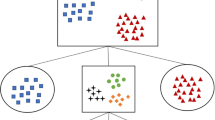Abstract
It is known that generated knowledge models for data mining tasks are dependent upon supplied data sets, so supplying good data sets for target data mining algorithms is important for the success of data mining. Therefore, in order to find better RBF networks of k-means clustering efficiently, we refer to the number of errors that are from decision trees, and use the information to improve training data sets for RBF networks and we also refer to terminal nodes to initialize the k value. Experiments with real world data sets showed good results.
This work was supported by Dongseo University, "Dongseo Frontier Project" Research Fund of 2010.
Access this chapter
Tax calculation will be finalised at checkout
Purchases are for personal use only
Preview
Unable to display preview. Download preview PDF.
Similar content being viewed by others
References
Tan, P., Steinbach, M., Kumar, V.: Introduction to Data Mining. Addison Wesley, Reading (2006)
Bishop, C.M.: Neural networks for pattern recognition. Oxford University Press, Oxford (1995)
Heaton, J.: Introduction to Neural Networks for C#, 2nd edn. Heaton Research Inc. (2008)
Lippmann, R.P.: An Introduction to Computing with Neural Nets. IEEE ASSP Magazine 3(4), 4–22 (1987)
Howlett, R.J., Jain, L.C.: Radial Basis Function Networks I: recent developments in theory and applications. Physica-Verlag, Heidelberg (2001)
Russel, S., Novig, P.: Artificial Intelligence: a Modern Approach, 2nd edn. Prentice Hall, Englewood Cliffs (2002)
Quinlan, J.R.: C4.5: Programs for Machine Learning. Morgan Kaufmann Publishers, Inc., San Francisco (1993)
Larose, D.T.: Data Mining Methods and Models. Wiley-Interscience, Hoboken (2006)
Shenouda, E.A.M.A.: A Quantitative Comparison of Different MLP Activation Functions in Classification. In: Wang, J., Yi, Z., Żurada, J.M., Lu, B.-L., Yin, H. (eds.) ISNN 2006. LNCS, vol. 3971, pp. 849–857. Springer, Heidelberg (2006)
Orr, M.J.L.: Introduction to Radial Basis Function Networks, http://www.anc.ed.ac.uk/~mjo/intro.ps
Kubat, M.: Decision Trees Can Initialize Radial-Basis Function Networks. IEEE Transactions on Neural Networks 9(5), 813–821 (1998)
Schwenker, F., Kestler, H.A., Palm, G.: Three learning phases for radial-basis-function networks. Neural Networks 14, 439–458 (2001)
Fukunaga, K., Hayes, R.R.: Effects of Sample Size in Classifier Design. IEEE Transactions on Pattern Analysis and Machine Intelligence 11(8), 873–885 (1989)
Chawla, N.V., Bowyer, K.W., Hall, L.O., Kegelmeyer, W.P.: SMOTE: Synthetic Minority Over-sampling Technique. Journal of Artificial Intelligence Research 16, 341–378 (2002)
Mazuro, M.A., Habas, P.A., Zurada, J.M., Lo, J.Y., Baker, J.A., Tourassi, G.D.: Training neural network classifiers for medical decision making: The effects of imbalanced datasets on classification performance. Neural Networks 21(2-3), 427–436 (2008)
Sug, H.: An Objective Method to Find Better RBF Networks in Classification. In: Proceedings of the 5th International Conference on Computer Sciences and Convergence Information Technology, vol. 1, pp. 373–376 (2010)
Suncion, A., Newman, D.J.: UCI Machine Learning Repository. University of California, School of Information and Computer Sciences, Irvine, CA (2007), http://www.ics.uci.edu/~mlearn/MLRepository.html
Kohavi, R.: Scaling up the accuracy of Naive-Bayes classifiers: a decision-tree hybrid. In: Proceedings of the Second International Conference on Knowledge Discovery and Data Mining, pp. 202–207 (1996)
Statlog (Landsat Satellite) Data Set, http://archive.ics.uci.edu/ml/datasets/Statlog+%28Landsat+Satellite%29
Witten, I.H., Frank, E.: Data Mining, 2nd edn. Morgan Kaufmann, San Francisco (2005)
Author information
Authors and Affiliations
Editor information
Editors and Affiliations
Rights and permissions
Copyright information
© 2011 Springer-Verlag Berlin Heidelberg
About this paper
Cite this paper
Sug, H. (2011). Using Quick Decision Tree Algorithm to Find Better RBF Networks. In: Nguyen, N.T., Kim, CG., Janiak, A. (eds) Intelligent Information and Database Systems. ACIIDS 2011. Lecture Notes in Computer Science(), vol 6591. Springer, Berlin, Heidelberg. https://doi.org/10.1007/978-3-642-20039-7_21
Download citation
DOI: https://doi.org/10.1007/978-3-642-20039-7_21
Publisher Name: Springer, Berlin, Heidelberg
Print ISBN: 978-3-642-20038-0
Online ISBN: 978-3-642-20039-7
eBook Packages: Computer ScienceComputer Science (R0)




